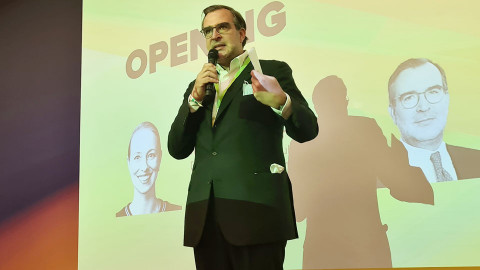Young, innovative, quick to act and successful – these are the kind of attributes most people particularly associate with start-ups. No wonder, that even established medium-sized companies and large corporations are founding new start-ups or acquiring young enterprises. The hkp/// group study “Pay for Pioneers 2020 - Organization & Compensation in Corporate Start-ups” examines how such corporate start-ups are organizationally linked and how their compensation schemes are set up. hkp/// group experts Viktoria Jahn and Petra Knab-Hägele talked to hkp.com about the study’s findings.
Ms. Jahn, Ms. Knab-Hägele, what do established companies aim to achieve by founding or acquiring start-ups?
Petra Knab-Hägele: It very much comes down to the characteristics start-ups are known for: agility, flexibility and the ability to innovate. Corporations in particular are striving for an agile fleet, in which their own – often increasingly unwieldly – tankers are surrounded by smaller, more powerful support vessels and speedboats.
Viktoria Jahn: Companies are willing to experiment with start-ups to open up new areas of business and, of course, they also want to benefit from that very unique entrepreneurial spirit of start-up founders and employees.
How common are start-ups that reside under the umbrella of larger companies?
Petra Knab-Hägele: Corporate start-ups are now a well-established part of the business world. Participants in the study, more than half of whom are listed, include representatives with start-ups in the fields of technology, automotive manufacturers and supplier, IT and internet as well as in transport and logistics.
Viktoria Jahn: Although corporate start-ups can be found in all industries they are particularly common in those with a long-established high level of innovation or in those undergoing radical change. Simply said, these branches are where the pressure to act is greatest.
Does “particularly common” mean that some companies operate several start-ups under one roof at the same time?
Petra Knab-Hägele: In fact, the majority of companies head several start-ups. 51 major companies took part in the study. A quarter of these operate between two and four start-ups, and more than half between five and twenty of such projects. The indications are clear: start-ups – especially a larger number of them – working under the umbrella of established companies have become best practice. Entire teams are already being tasked with their organization and management.
How are these young enterprises organizationally linked to their parent companies?
Viktoria Jahn: Start-ups are connected via specific organizational units, legally independent subsidiaries or special incubators – the latter in particular in companies operating a larger number of start-ups.
Petra Knab-Hägele: However, independent subsidiaries dominate with 85 percent, with around half of the study participants using more than one form of organizational in parallel.
And how large are these start-up units?
Viktoria Jahn: Around one third of the study participants have start-ups with more than 50 employees. At 14 percent each, the number of employees even exceeds 100 and 250 respectively, why we would tend to speak of maturing young companies in these cases.
In view of these sizes and organizational links, the issue of collective agreements is more relevant than it at first seems...
Viktoria Jahn: At least it is relevant for almost quarter of the study participants: 8 percent are bound by collective agreements, and 15 percent are at least partially bound by collective bargaining law.
Petra Knab-Hägele: This actually runs counter to corporate start-up objectives. The same applies to the guaranteed right of return for corporate employees who have been transferred to start-ups. Such guarantees are in place for a third of the study participants in case a start-up project fails.
Independent, non-corporate start-ups have the reputation for offering little security but plenty of opportunities through compensation or equity participation. Is this similar for corporate start-ups?
Petra Knab-Hägele: Only partially. More than half of the corporate start-ups pay base salary at the same level as the parent company. In about half of the start-ups, the annual bonus is also equivalent. 7 percent of corporate start-ups guarantee their employees minimum payouts within their short-term variable compensation schemes.
What about multi-year variable compensation?
Viktoria Jahn: The first thing to note is that 40 percent of corporate start-ups have not implemented any long-term incentive plans. However, if this is the case, the multi-year compensation is in most cases higher than in the parent company.
Are there any guarantees?
Viktoria Jahn: No, guaranteed minimum payments are not included in the multi-year variable compensation. In three out of four corporate start-ups, payout caps are defined. In 90 percent, the multi-year variable compensation is paid out in cash; it is not customary in the market to pay it out in shares or in the form of equity, although our market practice shows deviations from this study result in many cases.
Petra Knab-Hägele: 40 percent let their employees participate from the company's value virtually. About one-third use performance cash plans as long-term incentives - another remnant from the corporate world that we don't find in the environment of independent startups.
Are companies able to transfer the advantages of these young, dynamic organizations to the corporate world via their own start-ups or to profit from such activities?
Viktoria Jahn: Compared with independent start-ups, corporate start-ups have a reward-risk profile, which is characterized by more security and less risk – and this has influence on attracting, retaining and motivating talent critical to success.
Petra Knab-Hägele: Companies are on the right path but are often still too willing to compromise. Trying to combine the best of both worlds is not the right way forward. Corporate start-ups are successful when the entrepreneurial spirit typical for young companies is maintained, including the corresponding level of freedom involved. This could, for example, be achieved through extensive capital investments, attractive prospects in the event of success or consistent flexibility in terms of working hours. Collective agreements, classical compensation schemes and return guarantees are understandable but they counteract this.
Ms. Jahn, Ms Knab-Hägele, thank you for the interview.




